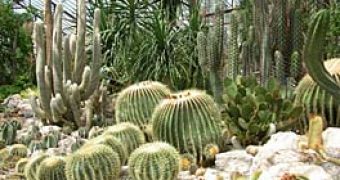1.There are over 2,000 species of cacti, with various shapes and forms. Caldera cacti in southwestern US can overcome 20 m (66 ft) on height, while Rebutia cacti from Bolivia and Argentina are just several centimeters tall. Some cacti look like chandeliers or columns, others are flattened or oval, looking like ears (Opuntia). There are cacti looking like curled snakes. Some look like a barrel or a small boar, perfectly rounded. Other cacti look like starfish or wrinkled human faces covered by a white spiny raveled wool pile.
The cactus stems are thickened, storing water, and the leaves are transformed into spines.
2.Even the smallest cactus species have large roots, which can be very profound or superficial, absorbing water from the soil. Cereus cacti have white flowers, while Opuntia species use to have red, pink, yellow or violet flowers. Some cactus flowers stand for several days, others die in just one day. Some cactus flowers open only at the sunset, others only in the daylight.
3.Depending on the species, cactus's spines can be extremely fragile or terrible venomous spikes, several centimeters long.
4.Cacti are pollinated by insects and hummingbirds. Some red cactus flowers spread a stenchy rotten meat scent, attracting insects.
5.The roots of a Mexican cactus, peyotl (Lophophora williamsii), were chewed by Aztecs for its hallucinogenic properties. The also made a type of infusion from these roots. Peyotl allowed the shamen to enter in trance. The psychoactive chemicals in peyotl are some alkaloids, especially mescaline. These properties of the cacti were also used by some Native Americans during the pre-Columbian era for anesthesia of the patients in case of operations.
6.Cacti are real water reservoirs; their inner liquid is not pure, clear water but a thick viscous stuff, but perfectly drinkable, that saved many lives in the desert. It can be obtained easily by scratching an Opuntia or by making a hole into columnar cacti.
7.The trunk of some cacti is used to make a type of Argentinian drum called bombo leguero. The wood of some cactus species is used for making walls, roofs and as reinforcement wood. The fruit of some cactus species, like Opuntia phaeacantha, can be eaten, being called prickly pear. The fruits of Cereus repandus from Peru are called cactus apple or tuna and are prickless. Syrup can be made from cactus fruits.
8.Cactus spines can be used for sutures, after they have been first sterilized on hot coal.
9.Cacti have periods of growth and blossom and periods of resting. During the growth, they prefer direct sun light, high temperatures and humidity (the plant will be watered often, but with a good drainage). Direct sun light will induce rapid growth and the development of longer and brighter spines. During the resting periods, the plants will be kept at cool temperatures (6-8o C), with reduced humidity (just one weekly watering) and in diffuse light.
Cactus transplanting is made in March, using small pots containing a mix of garden soil, leaf litter, sand, vegetal coal, broken bricks and mortar. For transplanting them in larger pots together with other cacti, they are put together with their soil and the empty space is filled with soil or sand.
10. Cacti can be bred via seeds (impossible in apartments) or stem cuttings. Cuttings' rooting is made in warm sand (20-21o C), with moderate humidity, after the cuttings have been left to rest for a week. This removes the danger of rotting during their rooting.

 14 DAY TRIAL //
14 DAY TRIAL //